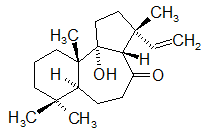Salvia parryi
Salvia parryi (Parry's sage) is a perennial subshrub that is endemic to Northern Mexico (Sonora state), southwestern New Mexico, and southern Arizona, growing at 3,500 to 5,000 ft (1,100 to 1,500 m) elevation.[1][2]
| Salvia parryi | |
|---|---|
| Scientific classification | |
| Kingdom: | Plantae |
| Clade: | Tracheophytes |
| Clade: | Angiosperms |
| Clade: | Eudicots |
| Clade: | Asterids |
| Order: | Lamiales |
| Family: | Lamiaceae |
| Genus: | Salvia |
| Species: | S. parryi |
| Binomial name | |
| Salvia parryi | |
Native people used preparations of the roots to treat gastric disorders. Parryin is a pimarane-derived diterpene isolated from this plant. Other compounds found in this species are isopimara-8(14),15-dien-7-one, isopimara-6,8(14),15-triene and isopimara-8,15-dien-7-one.[3]

Parryin
References
- "Salvia parryi". USDA Plants Profile. United States Department of Agriculture. Retrieved 29 January 2012.
- Kearney, Thomas Henry; Robert Hibbs Peebles (1960). Arizona Flora. University of California Press. p. 742.
- Touché et al. Phytochemistry, Vol. 45, No. 2, pp. 387-390, 1997
This article is issued from Wikipedia. The text is licensed under Creative Commons - Attribution - Sharealike. Additional terms may apply for the media files.